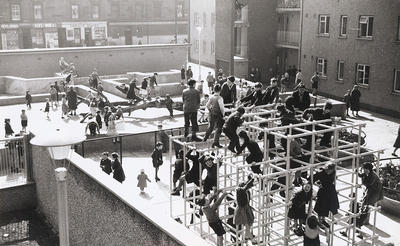
Children at play in a new playground in Hutchesontown, 1958. Demolition and rebuilding went hand in hand in the redevelopment of Hutchesontown under the Comprehensive Development Area plan of the late 1950s. Here, new high-rise houses stand alongside old tenements (visible in the background). Planners were proud of the areas they set aside for children's playgrounds, which were intended to give youngsters a place for play other than on the busy streets.
Like many multi-storey housing developments of the time, the new Hutchesontown homes suffered from poor "thermal performance", made worse by their open balconies, exposed positions and expensive-to-run off-peak electric storage heating systems. The resulting cold and damp conditions led to widespread condensation and mould-related problems in the homes and considerable discomfort for residents. Some flats in the area became uninhabitable, and were demolished after a lifetime of less than thirty years.
Reference: Post-war housing no.2, A/30/F/6
Reproduced with the permission of Glasgow City Council, Libraries Information and Learning
Keywords:
children, climbing frames, council houses, dampness, Glasgow Corporation, heating, housing estates, housing schemes, multi-storey flats, playgrounds, slum clearance, urban regeneration
You have 26 images in your photo album.